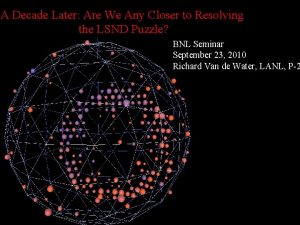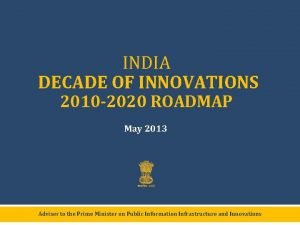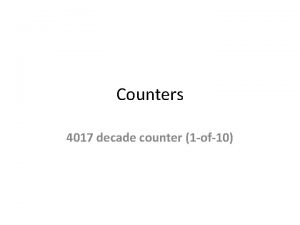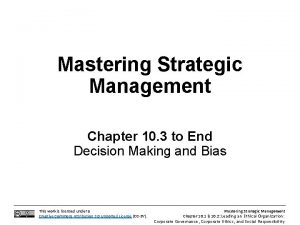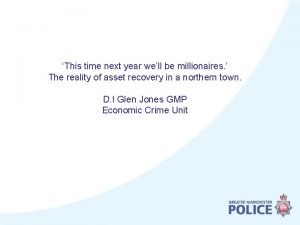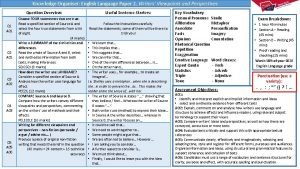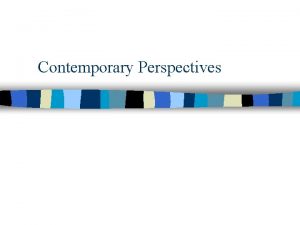Tomorrow Next Year Next Decade Never Perspectives of





![Natural Gas Demand Projections by Sector [tcf] Source: EIA (2006) -6 - Natural Gas Demand Projections by Sector [tcf] Source: EIA (2006) -6 -](https://slidetodoc.com/presentation_image/14e85c7b3c083f55df5cafaf38dae784/image-6.jpg)






























- Slides: 36

Tomorrow, Next Year, Next Decade, Never? Perspectives of Liquefied Natural Gas Development in the U. S. Sophia Ruester and Anne Neumann EE² Dresden University of Technology, Germany Chair of Energy Economics and Public Sector Management 4 th Transuniversity Colloqium Oxford Institute for Energy Studies, November 10, 2006 -1 -

Agenda 1. Introduction 2. Demand 3. Supply 4. Costs and Prices 5. Additional Infrastructure Required 6. Conclusions 7. Backup -2 -

Main Findings 1. The United State’s supply-demand-gap will increase 2. increasing import dependency 2. Formerly uneconomic supply sources become economic 3. deeper waters, Alaska, LNG 3. In the midterm it will not be possible to meet demand without LNG 4. LNG also for “base-load” energy demand 4. Non-U. S. territory LNG facilities will play an important role 5. circumvention of NIMBY problems and associated costs -3 -

Agenda 1. Introduction 2. Demand 3. Supply 4. Costs and Prices 5. Additional Infrastructure Required 6. Conclusions 7. Backup -4 -

Supply and Demand by Region Alaska Reserves: 235 Production: 13 Consumption: 11 Central U. S. Northeastern U. S. Reserves: 1323 Production: 98 Consumption: 49 Midwest U. S. Reserves: 114 Production: 10 Consumption: 111 Reserves: 219 Production: 12 Consumption: 108 Western U. S. Reserves: 74 Production: 9 Consumption: 100 Southeastern U. S. Reserves: 190 Production: 12 Consumption: 74 Southwestern U. S. Reserves: 2692 Production: 389 Consumption: 175 Source: EIA, 2004 values, in bcm -5 -
![Natural Gas Demand Projections by Sector tcf Source EIA 2006 6 Natural Gas Demand Projections by Sector [tcf] Source: EIA (2006) -6 -](https://slidetodoc.com/presentation_image/14e85c7b3c083f55df5cafaf38dae784/image-6.jpg)
Natural Gas Demand Projections by Sector [tcf] Source: EIA (2006) -6 -

Agenda 1. Introduction 2. Demand 3. Supply 4. Costs and Prices 5. Additional Infrastructure Required 6. Conclusions 7. Backup -7 -

Demand centers Supply centers -8 -

Interstate Natural Gas Flow Summary Source: EIA (2005) -9 -

Production Domestic production stagnates, furthermore Canadian production declines, consumption will grow The supply-demand gap will continue to increase and the country become more dependent on natural gas imports - 10 -

Projected Structure of Imports - Canadian deliveries will decline - Net exports to Mexico will increase - most of projected growth in natural gas imports will be LNG [tcf] 137 bcm 42 bcm -15 bcm Source: EIA (2006) - 11 -

LNG Scenarios - currently 3% of domestic consumption - currently 15% of total imports - share / importance will increase 207 bcm [tcf] 123 bcm 53 bcm Source: EIA (2006) - 12 -

Agenda 1. Introduction 2. Demand 3. Supply 4. Costs and Prices 5. Additional Infrastructure Required 6. Conclusions 7. Backup - 13 -

LNG Supply Situation Alaska Norway Russia Middle East North Africa Latin America West Africa Asia Oceania mtpa in 2005 Australia mtpa in 2010 Sources: IEA (2004), Cedigaz (2004), OME (2001) LNG supply costs are in the range of 3 $/MBTU. - 14 -

Natural Gas Supply Costs Chicago Houston Domestic natural gas production LNG imports Average U. S. production costs: 0. 84 $/MBTU Typical LNG delivery supply costs: 3 $/MBTU Pipeline transportation costs: 1 $/MBTU per 1000 miles Pipeline transportation costs: 1 $/MBTU About 4 $/MBTU for deliveries to Chicago About 1. 84 $/MBTU for deliveries from Rockies or Gulf of Mexico to Chicago Sources: FERC, IEA, EIA, NYMEX - 15 -

Henry Hub Price Development Current Henry Hub spot price: 5. 82 $/MBTU - 16 -

Citygate- and Wellhead Price Development Current citygate price Chicago: 7. 34 $/MBTU - 17 -

Agenda 1. Introduction 2. Demand 3. Supply 4. Costs and Prices 5. Additional Infrastructure Required 6. Conclusions 7. Backup - 18 -

Natural Gas Pipeline Grid Expansions Alaska Pipeline Rockies Express o st e i ck c o R cifi Pa - 19 -

Five Existing LNG Terminals Four constructed in the wake of high oil prices of 1970 s: - Shutdown in the 1980 s, reopened recently - Expansions planned and/or already realized - Distrigas’ Everett, MA: 1971 - El Paso’s Elba Island, GA: 1978 (2001) - Dominion’s Cove Point, MD: 1978 (2003) - Southern Union’s Lake Charles, LA: 1982 (1988) First new North American Facility: - Excelerate’s Gulf Gateway Energy Bridge (2005) - 20 -

Existing and Proposed North American LNG Terminals Source: FERC (2006) - 21 -

Advanced New Projects I – Gulf of Mexico - Benefit from existing infrastructure - domestic production matures - existing pipelines to main consuming areas - trading hubs (HH, Katy, Houston Ship Channel) - industrial area, no NIMBY problem - Large consumers in Texas and Louisiana - Facilities under construction: - Freeport LNG, TX (1. 5 Bcf/d, start up 2007, expansion under discussion) - Cameron LNG, LA (1. 5 Bcf/d, start up 2008) - Golden Pass LNG, TX (2 Bcf/d, start up 2009) - Expected: - Sabine Pass, Gulf Landing (offshore), Vista Del Sol - 22 -

Construction is under way… - 23 -

Advanced New Projects II – Non - U. S. Territory -Strong NIMBY attitude in California, Florida – but increasing demand, especially in the power generation sector Mexico Energia Costa Azul Terminal (Sempra Energy) - first Pacific cost facility - 1 Bcf/d, under construction, start up 2008 - Baja California (Chevron Texaco) - 1. 4 Bcf/d, proposed, potential start up 2010 Bahamas -Two advanced projects: - Tractebel’s Calypso (0. 8 Bcf/d, 2008) - AES’ Ocean Express (0. 8 Bcf/d, 2009) - 24 -

Advanced New Projects III – Non - U. S. Territory Canada - NIMBY in north-eastern U. S. - recently built (expandable) pipeline from Sable Island natural gas fields (1999, 530 MMBtu/d) Canaport LNG - Saint John/New Brunswick - Owned by Irving Oil, Repsol YPF - 1 Bcf/d - under construction, operation expected for 2008 Bear Head LNG - Point Tupper/Nova Scotia - Preparation of site of construction started in 2004 - Final construction verschoben - 1 Bcf/d, 2008 planned - 25 -

LNG Import Capacity Development (Nominal Values) Source: own estimation - Increase will slowdown after 2012 - 2017 Alaska Pipeline - 26 -

Agenda 1. Introduction 2. Demand Supply 3. Pipeline Infrastructure 4. LNG Infrastructure 5. LNG versus Pipeline Competition 6. Conclusions 7. Backup - 27 -

Conclusions The United State’s supply-demand-gap will increase increasing import dependency Formerly uneconomic supply sources become economic deeper waters, Alaska’s stranded resources, “base-load” LNG In the midterm it will not be possible to meet demand without LNG domestic production, pipeline supplies and LNG imports will co-exist Southern Pacific States (especially California) will need LNG Southeastern States will need LNG Northeastern States will need additional capacities Non-U. S. territory LNG facilities will play an important role circumvention of NIMBY problems and associated costs “yesterday” LNG was too expensive, therefore only for peak purposes “next year” LNG increasingly is able to compete with (domestic) pipeline sources - 28 -

Supply and Demand by Region Alaska Reserves: 235 Production: 13 Consumption: 11 Central U. S. Reserves: 1323 Production: 98 Consumption: 49 Northeastern U. S. Midwest U. S. Reserves: 114 Production: 10 Consumption: 111 Reserves: 219 Production: 12 Consumption: 108 Western U. S. Reserves: 74 Production: 9 Consumption: 100 Southeastern U. S. Reserves: 190 Production: 12 Consumption: 74 Southwestern U. S. Reserves: 2692 Production: 389 Consumption: 175 Source: EIA, 2004 values, in bcm - 29 -

Thank you very much for your attention! Any Questions or Comments? Contact: sophia. ruester@mailbox. tu-dresden. de www. ee 2. biz Research Program “Globalization of Natural Gas Markets”: http: //www. tu-dresden. de/wwbwleeg/projekte/gg. html? 7 EE² Dresden University of Technology Chair of Energy Economics and Public Sector Management - 30 -

Agenda 1. Introduction 2. Demand Supply 3. Pipeline Infrastructure 4. LNG Infrastructure 5. LNG versus Pipeline Competition 6. Conclusions 7. Backup - 31 -

Natural Gas Demand Projections by Sector II Source: EIA (2006) Units in trillion cubic feet Total: 22. 4 tcf (630 bcm) Total: 25. 9 tcf (717 bcm) Total: 27 tcf (756 bcm) - 32 -

Growth Rates U. S. Natural Gas Consumption - 33 -

Alaska Pipeline Project - Gas discovered in 1967 (stranded resources) - Focus on oil production and export - North Slope: 35 tcf proven (119 tcf estimated) - Pipeline to lower-48 states under discussion since 1970 s - 4. 5 bcf/d - A total of 3, 600 miles - Start up: 2017 Source: Tremaine (2006, 4) - Alternative: LNG option - 34 -

Alaska – LNG versus Pipeline Option Pipe Source: Tremaine (2006, 12) - 35 - LNG

Corporate Strategies Integration, Tolling, and New Entrants Integrated companies: - Upstream to downstream (e. g. Shell, BP) - Downstream to upstream (e. g. BG Group, SUEZ Group) Non integrated companies – “Tollers”: - Merchant traders, regasification capacity contracted to natural gas importers under “tolling agreements” - (e. g. Cheniere Energy) New business models - entry into the capital-intensive LNG business seems to be possible under the current, favorable conditions - New entrants (Excelerate – a newcomer with deep pockets) - Shipping companies (Golar LNG – from midstream to upstream & downstream) - 36 -
 Tomorrow and tomorrow shakespeare
Tomorrow and tomorrow shakespeare Tomorrow and tomorrow and tomorrow kurt vonnegut analysis
Tomorrow and tomorrow and tomorrow kurt vonnegut analysis Due tomorrow do tomorrow
Due tomorrow do tomorrow Due tomorrow do tomorrow
Due tomorrow do tomorrow X.next = x.next.next
X.next = x.next.next If tomorrow never comes elvis presley
If tomorrow never comes elvis presley Les bêtes de la mer
Les bêtes de la mer 1 decade later
1 decade later Terri rachals
Terri rachals Chapter 14 the sixties a decade of protest and change
Chapter 14 the sixties a decade of protest and change What is old susy’s place
What is old susy’s place The sixties a decade of protest and change
The sixties a decade of protest and change Dics innovatives
Dics innovatives 20s decade fashion
20s decade fashion Define radio drama
Define radio drama Decade counter circuit
Decade counter circuit Record peach harvest—price lowest in a decade
Record peach harvest—price lowest in a decade Global plan decade of action for road safety
Global plan decade of action for road safety We are never weary of the grand old song
We are never weary of the grand old song What runs but never walks
What runs but never walks If we had more rain our crops would grow faster
If we had more rain our crops would grow faster He never polishes his shoes, so he never looks smart.
He never polishes his shoes, so he never looks smart. Love never fails it never gives up
Love never fails it never gives up When all else fails god never does
When all else fails god never does Yr6 leavers poem
Yr6 leavers poem How will americans next year food
How will americans next year food Ensoel
Ensoel In your notebook write down the times
In your notebook write down the times This time next year we'll be millionaires
This time next year we'll be millionaires What's formal language
What's formal language In your notebook write questions about the people
In your notebook write questions about the people Paper 2 writers’ viewpoints and perspectives
Paper 2 writers’ viewpoints and perspectives The outrageous celebrity psychology
The outrageous celebrity psychology Gregor andrade
Gregor andrade Four perspectives of curriculum
Four perspectives of curriculum 7 perspectives in psychology
7 perspectives in psychology Contemporary perspectives in psychology
Contemporary perspectives in psychology







